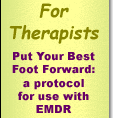
Somatosensory and visual priming of resource experiences for use with EMDR
"Put Your Best Foot Forward" is a semi-structured, one session therapy protocol aimed at empowering clients in routinely stressful situations. It targets the way the stress is experienced in the body, rather than the historical origins of the problem or the client’s stress management skills. Therapists trained in EMDR will find this protocol an easy fit with their pre-existing expertise. The protocol uses many of the same procedural components as the standard EMDR protocol. It has multiple clinical uses and is especially helpful if clients cannot get in touch with positive capacities through interview techniques.
Best Foot Forward is a non-logical, right brain kind of process that helps clients retrieve positive experiences they may not be consciously aware they have. The main retrieval mechanism is visual projection from body sense, somewhat like a somatic Rorschach test. The imagery that surfaces is processed in a structured three-part sequence. The focus is on affect at a physiological level. The image/affect/sensation triad then becomes the felt evidence on which to base a cognition. This collection of internalized, autogenetic resources is then used to reprocess the problem the client wishes to change. The entire process allows clients to find from within themselves a somatosensory counterbalance to a difficulty that has plagued them despite awareness and self-help books.
Put Your Best Foot Forward has always had the same general structure but its wording and interventions have gradually become refined with increased clinical use. Version 10 is now a four-page protocol covering eight procedural steps. It has specific wording as to process but is open-ended as to content. It uses many of the principles of Francine Shapiro’s standard EMDR protocol, including dual attention stimulation, present-time experiencing, and ratings of in-session change such as the SUDS scale. However, it extends EMDR’s somatosensory elements even further, into a strongly ‘bottom-up’ processing within a positive, humanistic orientation.
Other EMDR therapists say the protocol reminds them of a theoretical orientation in their background training. The “reminders” list is quite long and includes Gendlin’s Focusing-oriented Psychotherapy, NLP, Internal Family Systems Therapy (Richard Schwartz), Ahsen’s Eidetic Psychotherapy, Gestalt approaches to working with the body in therapy, and many other body-based therapies. Its strongest connection to my own background training is projective testing and Winnicott’s work in Object Relations Theory. This protocol may therefore have something for everyone! The consensus from therapists who have attended the workshops is that this is an empowerment protocol; the consensus from clients is that it increases confidence and self-trust. Working with the protocol is continually surprising and frequently very moving. Although we may not always know where the client’s resource imagery has come from, it always feels “just right."
The protocol has multiple applications:
 |
|
stand-alone therapy for a recurrent difficulty with physical symptoms (tension, knots, discomfort, heaviness etc.) |
 |
|
resource development in the early stages of therapy |
 |
|
preparation for trauma work; alternative to safe place procedure |
 |
|
adjunct in treatment of depression |
 |
|
empowerment of clients |
 |
|
when spliced together with the standard protocol, it becomes a useful crisis intervention procedure when a preexisting trauma underlies acute current stress
|
 |
|
reassessment of client's internal world after a period of therapy |
 |
|
useful when done in tandem with the standard EMDR protocol in ongoing therapy |
The Best Foot Forward protocol was originally trialed with 40 clients having Global Assessment of Functioning scores over 41, and problems typical of general clinical practice. Data has accumulated for over
150 now, including case reports from other therapists around the world. The
protocol continues to have a low risk profile when used with clients having GAF
scores at or above GAF 41.
Regardless of diagnosis or presenting problems, the projective imagery from the protocol seems to follow similar lines for many people. This suggests that mental health has broad generic themes, less complexly differentiated than the DSM IV classification of its absence. These generic patterns, and my proposed explanation for them in terms of memory systems and neural activation, now form the conceptual framework contained in the manual below.
Overview Paper
Click here to download a 13 page paper which is an overview of the Best Foot Forward process. A slightly shorter version of this paper was presented at the Rome EMDR conference in May 2003, and updated for publication in The EMDRIA Newsletter, Volume 8, Issue 3.
Clinical Practice Manual
Best Foot Forward Casebook
Workshops and Presentations
Ordering Information
Click here for reviews
|







